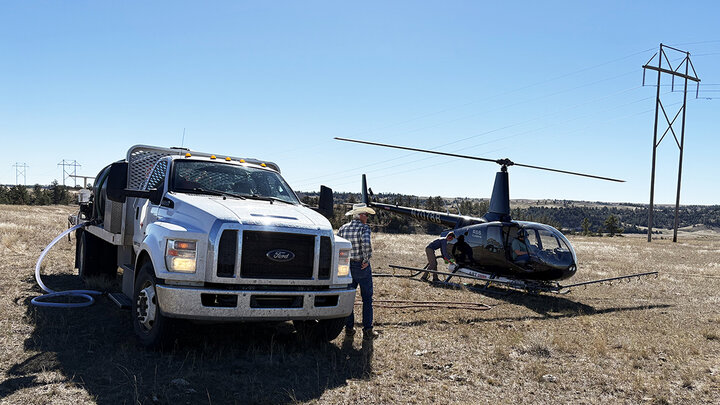By Dylan Mangel, Extension Plant Pathologist
Pathogen
The soybean cyst nematode (SCN) (Heterodera glycines) is a plant-parasitic roundworm. There are three main stages to the life cycle of the soybean cyst nematode. The cycle starts in the spring when temperature and moisture levels are adequate for egg hatch to release the juvenile nematode. Once a juvenile penetrates a soybean root, it moves through the root to the vascular tissue. In the vascular tissue the nematode establishes a feeding site. It then continues to feed and swell and eventually the females burst through the root tissue.
Video: Sampling for Soybean Cyst Nematode
Video: Identifying Soybean Cyst Nematode
Video: Managing Soybean Cyst Nematode
Eggs are produced mostly inside the female's body with some of eggs on the outside. The eggs on the outside of the body hatch and juvenile nematodes re-infect soybean roots. The egg-filled body of the dead female is what is referred to as the cyst. Each cyst can contain up to 400 eggs. There can be three to four generations of SCN in a single growing season. Soybean cyst nematode is the most yield limiting disease of soybean in the U.S.
Disease Symptoms
Field Symptoms
The first indication of a problem is when soybean yields are lower than expected or are dropping when soybean are planted in the field. Lower yields will usually be associated with dryer growing seasons. High SCN levels can cause plant stunting and yellowing. Above ground symptoms can be confused with damage from compaction, nutrient deficiencies, drought stress, low-lying wet areas, herbicide injury and other plant diseases. Circular to oval areas of stunted, yellowed plants can be observed. Low levels of SCN can cause significant yield loss with no noticeable above ground symptoms. For this reason, many producers are unaware of the pest and are not actively managing for SCN. Areas of SCN injury are typically elongated in the direction of tillage practices since the cysts are spread by tillage equipment.


Plant Symptoms
Symptoms include stunted roots with fewer nitrogen-fixing nodules. SCN infestation may increase susceptibility to soil-borne fungal infections, such as Rhizoctonia. The only unique symptom or "sign" is the presence of the adult females and cysts on the roots. Adult females appear as extremely tiny lemon-shaped bodies on the roots and are initially cream-colored. They later turn yellow and finally tan to brown as they mature to form the cyst. These are seen with the unaided eye and are much smaller than nitrogen nodules. Observation of adult females and cysts on the roots is one way to confirm SCN infestations in a field. In most SCN-infested fields in Nebraska, females are evident on roots by July 4 or after; however, the absence of cysts on the roots does not mean a field is free of SCN. In fields with a low population, very few cysts may be found on the roots and they may be easy to miss by visual observation. The only way to know a field is free of SCN is with a soil test.




Favorable Environmental Conditions
Weather conditions which favor maximum soybean yields are those which favor maximum SCN reproduction. In years with dryer conditions, especially in sandy soils, yield losses are higher. In a regional survey, higher SCN populations have been associated with sandier, well-drained soils. Fields in no-till with high clay content soils tend to have lower SCN populations. High soil pH is also associated with high SCN populations.

Sampling Procedure
The Nebraska Soybean Board is sponsoring soybean cyst nematode sample analysis through the University of Nebraska Applied Soybean Pathology Lab. Contact your local Extension Office for a SCN sampling kit. To find your local extension office, search the County Extension Finder.
Following is the procedure for taking soil samples for SCN. Items needed: Bucket, permanent marker, soil probe, soil sample collection bag.
- Press the soil probe at an angle into the root zone 6-8 inches deep. Remove probe from the soil and place the soil core into the bucket.
- Continue collecting soil cores at 20-25 locations throughout the field, or part of a field, following your predetermined randomized pattern.
- Place all the cores into the bucket, crush or break them, and mix the soil thoroughly. Fill the soil sample bag to the fill line.
- Make sure to fully fill out the required information on the front of the bag and adequately seal the bag.
- Contact information: name, address and telephone number.
- Number of acres the sample represents.
- Cropping history and current year's crop.
Submit samples to:
UNL Applied Soybean Pathology Lab
448 Plant Sciences Hall
P.O. Box 830722
Lincoln, NE 68583-0722
Testing should be repeated approximately every six years after initial confirmation of SCN to assess management and possible development of resistance. Sampling should also be repeated after management changes, to verify efficacy. It is important to sample at the same time of year and with the same crop in the field or following the same crop to get an accurate comparison. For example, if you sampled your field in the fall after harvest when soybeans had been planted in the field six years ago, it is important to resample in the fall following soybeans. If your rotation is such that soybeans weren’t planted six years after the initial test was taken, wait another year or two until you are taking the sample at the same time of year with the same crop growing or having been grown in the field.
SCN populations have been found in some Nebraska fields to reproduce on PI88788 varieties, the most common source of SCN resistance. This resistance is found in about 98% of all SCN-resistant varieties commercially available to Nebraska farmers. The SCN reproduction on these resistant varieties is not as great as on a susceptible variety, but it is great enough to affect SCN populations. If your egg counts are increasing rather than decreasing and you have planted SCN-resistant varieties, check for a soybean variety that has a different source of resistance or consider rotating out of soybeans for several years, possibly with four or five years of alfalfa.
Management
Genetic Resistance
Resistance to SCN has been identified and is available in many soybean varieties. A rotation of resistance sources is recommended for SCN infested fields. Anytime SCN is confirmed in a field, the following rotation should be used: non-host crop — resistant soybean — non-host crop — alternate resistant soybean. Additional years of the non-host crop will reduce the SCN population (number of eggs) further. When different SCN resistance sources cannot be identified (PI88788 is the most common), a change in resistant soybean variety should be substituted. All varieties with PI88788 are not the same as to their effect on SCN. More varieties with alternative SCN resistances are becoming available each year. The second most common resistance source is “Peking” resistance.
Cultural Practices
Yield loss due to SCN will be reduced by maintaining optimum growing conditions and avoiding plant stress. Moisture stress is the most common factor increasing SCN losses. Avoid spreading SCN by working and planting infested fields last. When possible, clean equipment before moving to the next field to minimize movement potential. Anything that moves soil will spread SCN.
Chemical/Biological Control
New nematicides are becoming available. While this is a broad class of chemistries, we lack data to make a broad use recommendation. The Soybean Cyst Nematode coalition recommends considering a nematode protectant seed treatment when planting a resistant variety. Never use a seed treatment in stead of a resistant variety. Varietal resistance is the most effective form of resistance.
Links
- The Soybean Cyst Nematode Coalition https://www.thescncoalition.com/
- UNL Nebraska Extension NebGuide Soybean Cyst Nematode Biology and Management (G1383)
- County Extension Finder
Soybean Diseases
- Soybean Diseases (Home)
- Anthracnose
- Bacterial Blight
- Bacterial Pustule
- Bean Pod Mottle Virus
- Brown Spot
- Brown Stem Rot
- Charcoal Rot
- Frogeye Leaf Spot
- Phytophthora Root and Stem Rot
- Pod and Stem Blight
- Purple Seed Stain
- Rhizoctonia Root Rot
- Sclerotinia Stem Rot
- Soybean Cyst Nematode (SCN)
- Soybean Mosaic Virus
- Soybean Rust
- Stem Canker
- Sudden Death Syndrome (SDS)








